Alpine ibex
The Alpine ibex (Capra ibex), also known as the steinbock, bouquetin, or simply ibex, is a species of wild goat that lives in the mountains of the European Alps. It is a sexually dimorphic species with larger males that carry larger, curved horns. Their coat colour is typically brownish grey. Alpine ibex tend to live in steep, rough terrain near the snow line. They are also social, although adult males and females segregate for most of the year, coming together only to mate. Four distinct groups exist; adult male groups, female-offspring groups, groups of young individuals, and mixed-sex groups.
| Alpine ibex | |
|---|---|
_Zoo_Salzburg_2014_h.jpg) | |
| Male | |
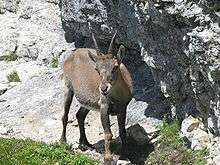 | |
| Female | |
| Scientific classification | |
| Kingdom: | Animalia |
| Phylum: | Chordata |
| Class: | Mammalia |
| Order: | Artiodactyla |
| Family: | Bovidae |
| Subfamily: | Caprinae |
| Genus: | Capra |
| Species: | C. ibex |
| Binomial name | |
| Capra ibex | |
| Range map in the Alps | |
During the breeding season, males fight for access to females and use their long horns in agonistic behaviours. After being extirpated from most areas by the 19th century, the Alpine ibex was successfully reintroduced to parts of its historical range. All individuals living today descend from the stock in Gran Paradiso National Park in Aosta Valley. This national park was created to help the ibex to thrive. The ibex is the emblem of both the Gran Paradiso National Park and the Vanoise National Park. The species is currently listed as of least concern by the IUCN, but went through a population bottleneck of less than 100 individuals. This has led to very low genetic diversity across populations.
Taxonomy and phylogeny
The Alpine ibex was first described by Carl Linnaeus in 1758. It is classified in the genus Capra (Latin for "goat") with at least seven other species of wild goats. Both Capra and Ovis (sheep) descended from a goral-like animal from the Miocene and early Pliocene, whose fossils are found in Kenya, China, and Slovenia. The genus Tossunnoria appears in China during the late Miocene and appears to have been intermediate between gorals and goats. Fossils of Alpine ibex date back to the late Pleistocene, when the Spanish ibex and it probably evolved from the extinct Pleistocene species Capra camburgensis.[2] The Nubian (C. nubiana), Walia (C. walie), and Siberian ibex (C. sibirica) were previously considered to be subspecies of the Alpine ibex, giving populations in the Alps the trinomial of C. i. ibex.[3]
Appearance
Compared with other members of its genus, the Alpine ibex has a short, broad head and a duller coat. It has brownish-grey hair over most of the body, a pale abdomen, and slightly darker markings on the chin and throat and in a stripe along the back. They moult twice a year, firstly in April or May, and then again in September, when they replace the short summer coat with thicker hair and a woolly undercoat.[2]
Males commonly grow to a height of 90 to 101 cm (35 to 40 in) at the withers, with a body length of 149 to 171 cm (59 to 67 in) and weigh from 67 to 117 kg (148 to 258 lb). Females are noticeably smaller, with a shoulder height of 73 to 84 cm (29 to 33 in), a body length of 121 to 141 cm (48 to 56 in), and a weight of 17 to 32 kg (37 to 71 lb). Both male and female Alpine ibex have large, backwards-curving horns with numerous ridges along their length. At 69 to 98 cm (27 to 39 in), those of the males are substantially larger than those of females, which reach only 18 to 35 cm (7.1 to 13.8 in) in length.[2]
Distribution and ecology
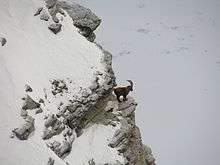
The Alpine ibex was, at one point, restricted only to the Gran Paradiso National Park in northern Italy, and in the Maurienne Valley in the French Alps [4] but it was reintroduced to most of the European Alps. Reintroductions started in 1906 into Switzerland. Alpine ibex are now found in most or all of the Italian and French alpine ranges, southern Germany, Switzerland[5] and Austria. It has also been introduced to Bulgaria and Slovenia.[1]
An excellent climber, its preferred habitat is the rocky region along the snow line above alpine forests, where it occupies steep, rough terrain at elevations of 1,800 to 3,300 m (5,900 to 10,800 ft).[6] Alpine ibex are typically absent from woodland areas,[2] although adult males in densely populated areas may stay in larch and mixed larch-spruce woodland if no snow has fallen.[7] Males spend the winter in coniferous forests.[2] For most of the year, males and females occupy different habitats.[8] Females rely on steep terrain more so than males.[9] Males use lowland meadows during the spring, which is when snow melts and green grass appears.[9] They then climb to alpine meadows during the summer.[7] When winter arrives, both sexes move to steep, rocky slopes that amass little snow.[10] They prefer slopes of 30–45° and use small caves and overhangs for shelter.[11] Home ranges are highly variable, depending on the availability of resources, and vary in size throughout the year. Figures from 180 to 2,800 ha (0.69 to 10.81 sq mi) have been recorded.[2][10] Home ranges tend to be largest during summer and autumn, smallest in winter, and intermediate in spring.[2] Female home ranges are usually smaller than those of males. Alpine ibex appear to have a low rate of predation and in Gran Paradiso typically die of age, starvation, or disease.[2]
Foraging
Alpine ibex are strictly herbivorous, with over half of their diet consisting of grasses, and the remainder being a mixture of mosses, flowers, leaves, and twigs.[2] If leaves and shoots are out of reach, they often stand on their rear legs to reach this food. Grass genera that are the most commonly eaten are Agrostis, Avena, Calamagrostis, Festuca, Phleum, Poa, Sesleria, and Trisetum.[2] The climbing ability of the Alpine ibex is such that it has been observed standing on the sheer face of the Cingino Dam in Piedmont, Italy, where it licks the stonework to obtain mineral salts.[12]
Life history
Although the Alpine ibex is a social species, they segregate sexually and spatially depending on the season.[9] Four types of groups exist: Adult male groups, female-offspring groups, groups of young individuals 2–3 years old, and mixed-sex groups.[2][13] Young groups are numerous at the beginning of summer, but are expelled by females at the end of their gestation period. Female and offspring groups occur year-round, at least in an area of the French Alps.[13] Mixed sex groups of adult males and females occur during breeding, which lasts from December to January. By April and May, the adults separate.[13] The largest aggregations of either sex occur during June and July. Gatherings of males begin to decrease during October and November, and are lowest from the rut from December to March.[13] The males then leave their separate wintering areas and gather again.[14]
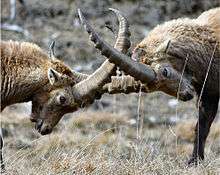
A linear dominance hierarchy exists among males. In small populations, which are more cohesive, males know their place in the hierarchy based on memories of past encounters,[2] while in mobile and large groups, where encounters with strangers are common, rank is based on horn size.[15] Antagonistic behavior in males can come in the form of "direct" or "indirect" aggression. With direct aggression, one male bumps another with his horns or places himself in front of his opponent. He stands on his hind legs and comes down on his opponent with his horns. This may signal that he is ready to clash or may be attempting a real clash.[2] Indirect aggression is mostly intimidation displays.[2]
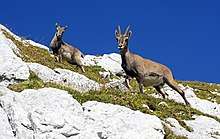
Reproduction and growth
The breeding season starts in December, and typically lasts around six weeks. During this time, male herds break up into smaller groups that search for females. The rut takes place in two phases. In the first phase, the male groups interact with the females that are all in oestrous. The higher the male's rank, the closer he can get to a female.[2] Males perform courtship displays. In the second phase of the rut, one male separates from his group to follow an individual female. He displays to her and guards her from other males. Before copulation, the female moves her tail and courtship becomes more intense. They copulate and then he rejoins his group and reverts to the first phase.[2] Gestation lasts around 167 days, and results in the birth of one or two kids, with twins making up about 20% of births.[16]
Alpine ibex reach sexual maturity at 18 months, but females do not reach their maximum body size for five to six years, and males not for 9-11 years. The horns grow throughout life, growing most rapidly during the second year of life, and thereafter by about 8 cm (3.1 in) a year, eventually slowing to half that rate once the animal reaches 10 years of age. Alpine ibex live for up to 19 years in the wild.[17]
Conservation status
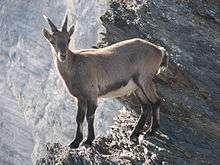
The Alpine ibex historically ranged through France, Italy, Switzerland, Liechtenstein, Bavaria, Austria and Slovenia. Starting in the early 16th century and with firearms becoming common, the overall population declined due to overexploitation and poaching. The ibex became extinct in Switzerland and Germany by the 18th century, and was extinct in Austria and northeastern Italy by the 19th century. They remained only in and around the adjacent Gran Paradiso and Vanoise Massifs, then both part of the Kingdom of Sardinia. Located in the western Italian Alps and the Maurienne valley in the north eastern French alps, bordering the Vanoise and Gran Paradiso Massif, the park was declared a royal hunting reserve in 1854 with the name of "Royal hunting reserve of Gran Paradiso" by Victor Emmanuel II, the first king of a united Italy .[18]
Ibex were protected from poaching and their numbers increased, reaching 3,020 in 1914. The ibex enjoyed further protection when Gran Paradiso was made into a national park in 1922. Animals from this population naturally dispersed into surrounding regions. However, reintroductions have been the predominant source of new populations. Today, the total population of Alpine ibex is over 30,000 and is considered to be of Least Concern by the IUCN. However, Alpine ibex do have low genetic diversity putting them at risk of inbreeding depression.[1][19]
In popular culture
The Alpine ibex is a mountain icon. It is represented in many official emblems throughout the Alpine range, from France to Austria, as in the coat of arms of the Canton of Grisons in Switzerland or logos such as Pro Natura.
The animal is at the center of the Goldhorn legend. This, in turn, underlies the emblem of the Laško Brewery, the largest brewery in Slovenia. In addition, the first Slovene-language, full-length film, recorded in 1931 by Janko Ravnik, was titled In the Kingdom of the Goldhorn.
In 2009, DNA analysis of the stomach contents of the Alpine iceman known as "Ötzi" confirmed that his last meal included ibex meat.[20]
References
- Aulagnier, S.; Kranz, A.; Lovari, S.; Jdeidi, T.; Masseti, M.; Nader, I.; de Smet, K. & Cuzin, F. (2008). "Capra ibex". IUCN Red List of Threatened Species. 2008: e.T42397A10695445. doi:10.2305/IUCN.UK.2008.RLTS.T42397A10695445.en. Database entry includes a brief justification of why this species is of least concern.
- Parrini, F.; Cain III, J. W.; Krausman, P. R. (2009). "Capra ibex (Artiodactyla: Bovidae)". Mammalian Species. 830: 1–12. doi:10.1644/830.1.
- Shackleton, D. W. (1997). Wild Sheep and Goats and Their Relatives: Status Survey and Action Plan for Caprinae. International Union for Conservation of Nature and Natural Resources. Species Survival Commission. Caprinae Specialist Group. p. 12. ISBN 2831703530.
- Girard, Irène (2000). "Dynamique des populations et expansion geographique du bouquetin des alpes (Capra ibex ibex) dans le parc national de la vanoise". PhD thesis, Université Savoie Mont Blanc. Archived from the original on 2013-12-28. Retrieved 2013-09-07.
- (in French) Heinz Staffelbach, Manuel des Alpes suisses. Flore, faune, roches et météorologie, Rossolis, 2009 (ISBN 978-2-940365-30-2). Also available in German: Heinz Staffelbach, Handbuch Schweizer Alpen. Pflanzen, Tiere, Gesteine und Wetter, Haupt Verlag, 2008 (ISBN 978-3-258-07638-6).
- Parrini, F.; et al. (2003). "Spatial behaviour of adult male Alpine ibex Capra ibex ibex in the Gran Paradiso National Park, Italy". Acta Theriologica. 48 (3): 411–423. doi:10.1007/BF03194179.
- Grignolio, S.; Parrini, F.; Bassano, B.; Luccarini, S.; Apollonio, M. (2003). "Habitat selection in adult males of Alpine ibex, Capra ibex ibex" (PDF). Folia Zoologica. 52 (2): 113–20. Archived from the original (PDF) on 2013-05-22. Retrieved 2012-12-26.
- ToÏgo C.; Gaillard J. M.; Michallet J. (1997). "Adult survival pattern of the sexually dimorphic Alpine ibex (Capra ibex ibex)". Canadian Journal of Zoology. 75: 75–79. doi:10.1139/z97-009.
- Francisci, F., S. Focardi, and L. Boitani. (1985) "Male and female Alpine ibex: phenology of space use and herd size", pp. 124–133. in The biology and management of mountain ungulates. Lovari, S. Croom Helm. London, United Kingdom. ISBN 978-94-015-7346-7
- Grignolio, S.; et al. (2004). "Seasonal variations of spatial behaviour in female Alpine ibex (Capra ibex ibex) in relation to climatic conditions and age". Ethology Ecology and Evolution. 16 (3): 255–264. doi:10.1080/08927014.2004.9522636.
- Wiersema, G. (1984). "Seasonal use and quality assessment of ibex habitat". Acta Zoologica Fennica. 172: 89–90.
- Nutkins, Terry (3 November 2010). "The goats with a head for heights". Guardian.co.uk. Guardian News and Media Limited. Retrieved 4 November 2010.
- Villaret, J. C.; Bon, R. (1995). "Social and spatial segregation in Alpine ibex (Capra ibex) in Bargy, French Alps". Ethology. 101 (4): 291–300. doi:10.1111/j.1439-0310.1995.tb00366.x.
- Parrini, F.; Grignolio, S.; Luccarini, S.; Bassano, B.; Apollonio, M. (2003). "Spatial behaviour of adult male Alpine ibex Capra ibex ibex in the Gran Paradiso National Park, Italy". Acta Theriologica. 48 (3): 411–23. doi:10.1007/BF03194179.
- Schaller, G. B. (1977) Mountain monarchs: wild sheep and goats of the Himalaya. University of Chicago Press. Chicago, Illinois.
- Stüwe, M.; Grodinsky, C. (1987). "Reproductive biology of captive Alpine ibex (Capra i. ibex)". Zoo Biology. 6 (4): 331–339. doi:10.1002/zoo.1430060407.
- ToÏgo, C.; et al. (2007). "Sex- and age-specific survival of the highly dimorphic Alpine ibex: evidence for a conservative life-history tactic". Journal of Animal Ecology. 76 (4): 679–686. doi:10.1111/j.1365-2656.2007.01254.x. PMID 17584373.
- Stüwe, M.; Nievergelt, B. (1991). "Recovery of Alpine ibex from near extinction: the result of effective protection, captive breeding, and reintroductions". Applied Animal Behaviour Science. 29 (1–4): 379–87. doi:10.1016/0168-1591(91)90262-V.
- Biebach, I.; Keller, L. F. (2009). "A strong genetic footprint of the re-introduction history of Alpine ibex (Capra ibex ibex)". Molecular Ecology. 18 (24): 5046–58. doi:10.1111/j.1365-294X.2009.04420.x. PMID 19912536.
- Than, Ker (23 June 2011). "Iceman's Stomach Sampled—Filled With Goat Meat". National Geographic. Archived from the original on 26 June 2011. Retrieved 24 June 2011.
External links
| Wikimedia Commons has media related to Capra ibex. |
| Wikispecies has information related to Capra ibex |

_(2).jpg)